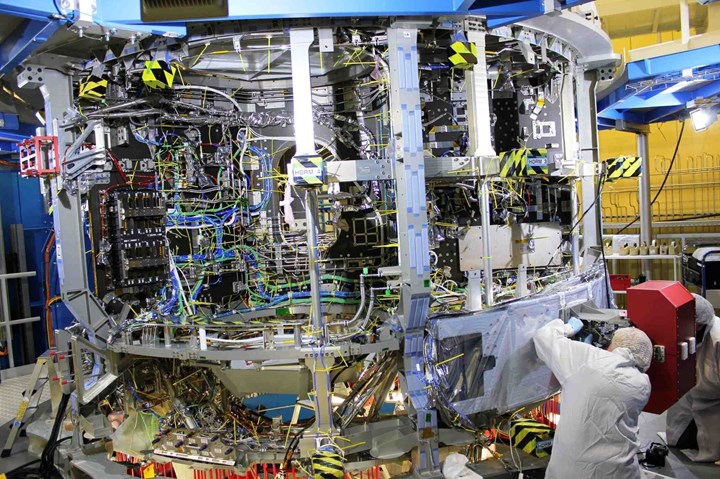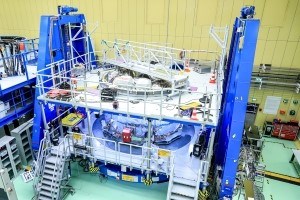Airbus delivers second composites-intensive European Service Module for NASA’s Orion spacecraft
The ESM-2 module, comprising carbon fiber sheets and 19-meter CFRP solar array wings, will provide propulsion, power and thermal control, as well as oxygen and water for astronauts on the Artemis II mission.

Integration of the ESM-2 for Orion. Photo Credit: Airbus
It was announced on Oct. 6 that the second composites-intensive European Service Module (ESM-2), built by Airbus (Toulouse, France) for NASA’s Orion spacecraft for the Artemis I and II moon missions, is ready for delivery from the Airbus site in Bremen, Germany. An Antonov cargo aircraft will fly the ESM-2 to NASA’s Kennedy Space Center in Fla., U.S. The European Space Agency (ESA) has selected Airbus as the prime contractor for the development and manufacture of six ESMs with the first ESM to fly soon on NASA’s Artemis I mission.
Airbus says the ESM is a key element of Orion, the next-generation spacecraft that will transport astronauts beyond low Earth orbit (LEO) for the first time since the end of the Apollo program in the 1970s. Comprised of more than 20,000 parts and components, ESM-2 is a cylinder around four meters high and wide. It has a distinctive four solar array wings (SAW, 19 meters across when unfurled) that generates enough energy to power two households. The service module’s 8.6 tons of fuel can power the main engine, eight auxiliary thrusters and 24 smaller thrusters used for attitude control.
While its primary structure is made from machined aluminum, the web assembly is composed of and aluminum sandwich, to stiffen the central core and accommodate most of the ESM equipment (i.e., pressurant tanks, water tanks, etc.). The craft’s four SAW are each composed of three deployable carbon fiber-reinforced polymer (CFRP) rigid panels; at launch, the ESM weighs a total of just over 13 tons.
Overall, the module provides propulsion, power and thermal control and will supply astronauts with water and oxygen on future missions. Furthermore, the unpressurized service module can be used to carry additional payload. The ESM is installed underneath the crew module and together they form the Orion spacecraft, which will reportedly enables astronauts to be transported further into space than ever before.
“Delivery of the second European Service Module for NASA’s Orion spacecraft marks another huge step forward on the journey to return astronauts to the moon,” says Andreas Hammer, head of space exploration at Airbus. “Working hand in hand with our customers ESA and NASA, and our industrial partner, Lockheed Martin Space [see “Lockheed Martin opens new facility, expands Orion spacecraft production”], the program is moving apace and we are ready to meet the challenges of returning to the lunar surface in 2024.”

Photo Credit: Airbus
ESM-2 underwent a comprehensive validation process prior to being readied for shipment including gimbal testing of the module’s main engine (which swivels from side to side for maneuvering and directional control during spaceflight). This main engine is a refurbished engine from Space Shuttle Atlantis orbiter spacecraft.
After completing its trans-Atlantic voyage, Airbus says the ESM-2 will be mated with the Orion Crew Module and undergo further extensive testing before integration with the launcher, a process that will take around two years.
The launch of the first Orion spacecraft on NASA’s new Space Launch System rocket will be uncrewed and take the spacecraft more than 64,000 kilometers beyond the moon in order to demonstrate its capabilities. The first human spaceflight mission, Artemis II, will be powered by ESM-2. Eventually, the Orion spacecraft will transport four astronauts, providing life support for the crew during the flight and enabling a safe return to Earth’s atmosphere, at extremely high re-entry speeds.
In the longer term, ESM is planned to dock Orion spacecraft with the International Lunar Gateway, a moon orbiting platform that will enable a sustainable space exploration architecture extending humanity’s presence in space.
Related Content
Revolutionizing space composites: A new era of satellite materials
A new approach for high volumes of small satellite structures uses low-CTE, low-cost CFRP cellular core, robust single-ply skins and modular panel systems to cut lead time, labor and cost for reflectors, solar arrays and more.
Read MoreExpanding high-temperature composites in India and the U.S.
Azista USA offers polymers and processes for carbon/carbon and other CMC, including novel hot-melt phenolic and phthalonitrile prepregs for faster cycle times, alternative solutions.
Read MoreOn the radar: Reusable launch vehicles, hypersonics make space more accessible
CFRP has become key to targeting efforts in reusing components like rocket stages, as well as the development of reusable hypersonic testbeds and spaceplanes, for increasing space commercialization.
Read MoreUltrasonic welding for in-space manufacturing of CFRTP
Agile Ultrasonics and NASA trial robotic-compatible carbon fiber-reinforced thermoplastic ultrasonic welding technology for space structures.
Read MoreRead Next
Ultrasonic welding for in-space manufacturing of CFRTP
Agile Ultrasonics and NASA trial robotic-compatible carbon fiber-reinforced thermoplastic ultrasonic welding technology for space structures.
Read MoreNext-gen fan blades: Hybrid twin RTM, printed sensors, laser shock disassembly
MORPHO project demonstrates blade with 20% faster RTM cure cycle, uses AI-based monitoring for improved maintenance/life cycle management and proves laser shock disassembly for recycling.
Read MoreCutting 100 pounds, certification time for the X-59 nose cone
Swift Engineering used HyperX software to remove 100 pounds from 38-foot graphite/epoxy cored nose cone for X-59 supersonic aircraft.
Read More












